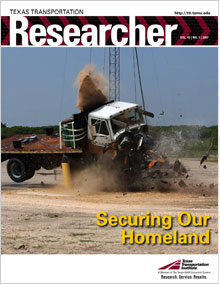College rivalries do not just involve sports teams. Academic institutions also compete for federal research dollars. But the academic community also works together on many projects, including combining resources to most effectively protect our nation.
Two groups—the Southwest Border Security Consortium (SBSC) and the Texas Homeland Security Group (THSG)—are striving to improve security in their respective regions. A leading member of both teams is Texas A&M Engineering.
Some in the private sector might charge that anything academia can do, they could do as well or better. In terms of providing practical solutions to real-world problems, TTI Associate Director Bill Stockton disagrees.
“Sometimes academia gets a bad rap for being exclusionary, elitist and too research oriented,” explains Stockton, who is also Texas A&M’s representative to the SBSC. “The reality is that we offer world-class staff, faculty and research facilities aimed at applied problem-solving. 9/11 reminded us that, research efforts conducted to solve one problem can be readily adapted to homeland security challenges. Furthermore, the universities in the southwest have been conducting a wide variety of significant research at the border for many years—we know the region.”
The SBSC focuses on advancing the security of the U.S. southwestern border by sharing resources and maintaining open communication among constituent universities. The consortium seeks to apply its unique assortment of world-class research, development, testing and evaluation assets to solve national security problems. Though focused on homeland security, this partnership has already produced real-world applications through other joint ventures among the partners, leading to successful teaming on non-security research opportunities. Over the long term, the partnership will also help border states overcome localized security challenges, as well as broaden and expand the research portfolios of participating universities.
The THSG—composed of Texas A&M and University of Texas institutions—evolved from the cooperative model established by Don Phillips, Chevron Professor of Industrial and Systems Engineering at Texas A&M. As academic institutions, the schools offer objective academic research and practical application. In short, they’re not vendors selling something; they’re public institutions acting in the public good. And because each component offers unique capabilities, the whole is truly greater than the sum of the parts.
Some habits die hard, but the spirit of cooperation encouraged by these groups enables member colleges to overcome old rivalries and work together to improve the country’s capability to predict, prevent and respond to security threats, for example: adapting expertise applied to disaster response, truck inspections and illegal drug interdiction. Each institution has learned to shed its individual school colors to join a bigger team with a vital mission.
“Throughout our history, American ingenuity has proven essential to the success and welfare of this nation,” notes Phillips. “There is no greater source of that kind of innovative thinking than in our higher institutions of learning.”
